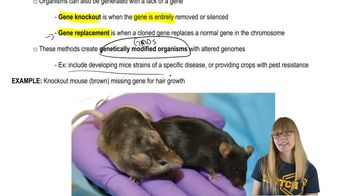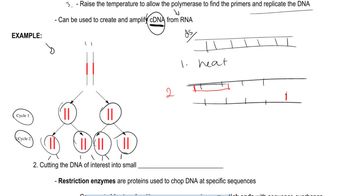Table of contents
- 1. Introduction to Genetics51m
- 2. Mendel's Laws of Inheritance3h 37m
- 3. Extensions to Mendelian Inheritance2h 41m
- 4. Genetic Mapping and Linkage2h 28m
- 5. Genetics of Bacteria and Viruses1h 21m
- 6. Chromosomal Variation1h 48m
- 7. DNA and Chromosome Structure56m
- 8. DNA Replication1h 10m
- 9. Mitosis and Meiosis1h 34m
- 10. Transcription1h 0m
- 11. Translation58m
- 12. Gene Regulation in Prokaryotes1h 19m
- 13. Gene Regulation in Eukaryotes44m
- 14. Genetic Control of Development44m
- 15. Genomes and Genomics1h 50m
- 16. Transposable Elements47m
- 17. Mutation, Repair, and Recombination1h 6m
- 18. Molecular Genetic Tools19m
- 19. Cancer Genetics29m
- 20. Quantitative Genetics1h 26m
- 21. Population Genetics50m
- 22. Evolutionary Genetics29m
18. Molecular Genetic Tools
Genetic Cloning
Problem 32a
Textbook Question
About 1% of occurrences of nonautoimmune type 1 diabetes are due to loss-of-function alleles in the insulin gene. Individuals heterozygous for such mutations develop diabetes as infants or in the first few years of their lives. Outline how you might approach gene therapy for such a disease and what difficulties you might encounter.
 Verified step by step guidance
Verified step by step guidance1
<Step 1: Identify the Target Gene and Mutation> Begin by identifying the specific loss-of-function mutation in the insulin gene that is responsible for the nonautoimmune type 1 diabetes in the patient. This involves sequencing the insulin gene to pinpoint the exact mutation.
<Step 2: Choose a Gene Delivery Method> Select an appropriate vector for delivering the correct version of the insulin gene to the patient's cells. Common vectors include viral vectors like lentivirus or adeno-associated virus (AAV), which are often used in gene therapy due to their efficiency in gene delivery.
<Step 3: Design the Therapeutic Gene Construct> Construct a therapeutic gene that includes the correct version of the insulin gene, along with necessary regulatory elements to ensure proper expression in the target cells. This construct should be inserted into the chosen vector.
<Step 4: Target the Appropriate Cells> Determine the specific cell types that need to be targeted for therapy. In the case of insulin, this would likely involve pancreatic beta cells, which are responsible for insulin production. Ensure that the vector can effectively deliver the gene to these cells.
<Step 5: Address Potential Challenges> Consider potential challenges such as immune responses to the vector, ensuring long-term expression of the gene, and avoiding insertional mutagenesis. Develop strategies to mitigate these issues, such as using immune-suppressive treatments or designing vectors with improved safety profiles.>
 Verified video answer for a similar problem:
Verified video answer for a similar problem:This video solution was recommended by our tutors as helpful for the problem above
Video duration:
1mPlay a video:
Was this helpful?
Key Concepts
Here are the essential concepts you must grasp in order to answer the question correctly.
Gene Therapy
Gene therapy involves the introduction, removal, or alteration of genetic material within a person's cells to treat or prevent disease. In the context of type 1 diabetes caused by insulin gene mutations, gene therapy could aim to deliver a functional copy of the insulin gene to pancreatic cells, potentially restoring insulin production. This approach requires precise delivery methods and safety considerations to avoid unintended effects.
Recommended video:
Guided course

Transgenic Organisms and Gene Therapy
Loss-of-Function Alleles
Loss-of-function alleles are mutations that result in reduced or abolished protein function. In the case of the insulin gene, such mutations can lead to insufficient insulin production, causing diabetes. Understanding the specific mutations involved is crucial for designing targeted gene therapies that can effectively compensate for the loss of function.
Recommended video:
Guided course

Functional Genomics
Challenges in Gene Therapy
Gene therapy faces several challenges, including delivery mechanisms, immune responses, and long-term expression of the therapeutic gene. For type 1 diabetes, ensuring that the delivered gene reaches the correct cells and functions properly is critical. Additionally, the risk of immune reactions against the introduced genetic material or the modified cells can complicate treatment outcomes.
Recommended video:
Guided course

Transgenic Organisms and Gene Therapy
Related Videos
Related Practice




